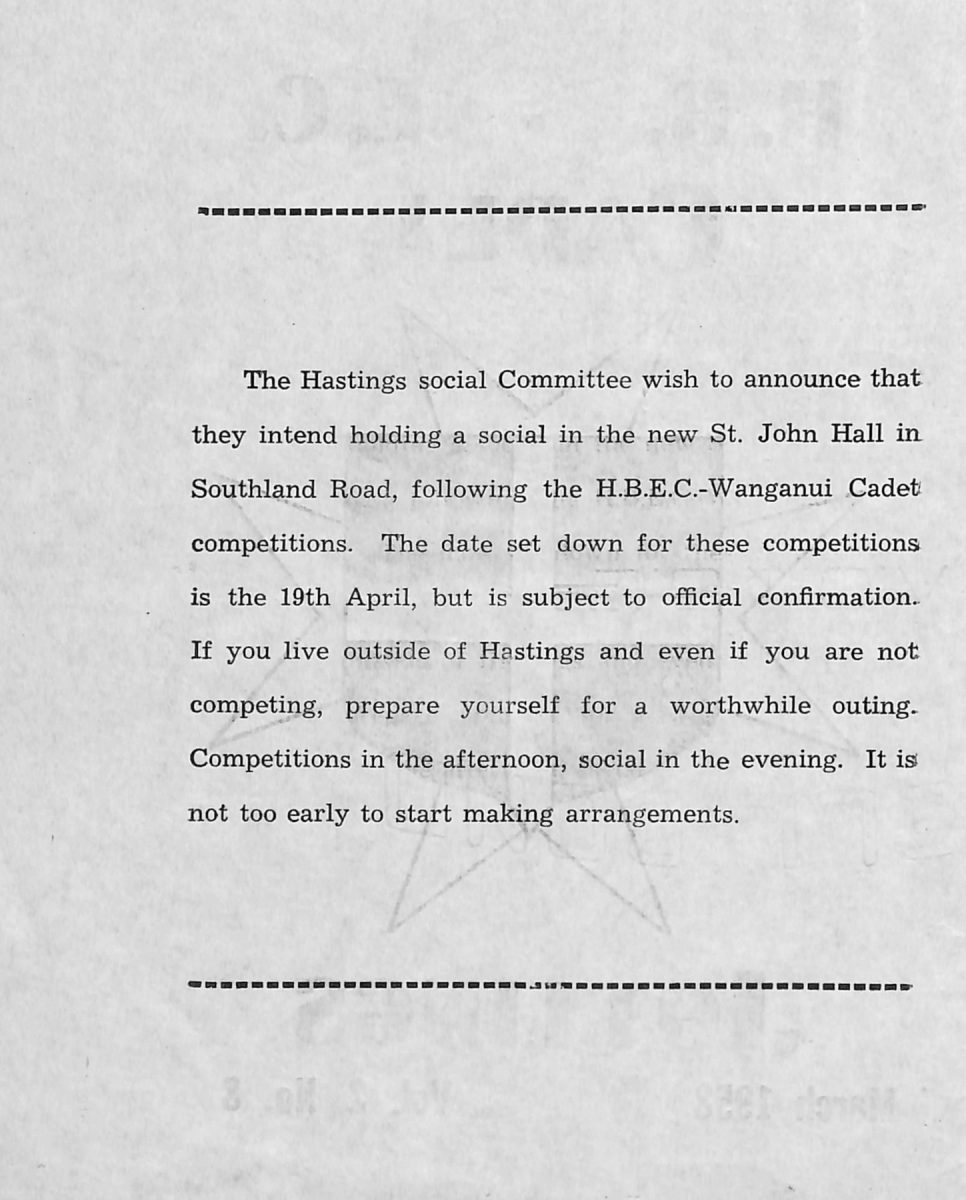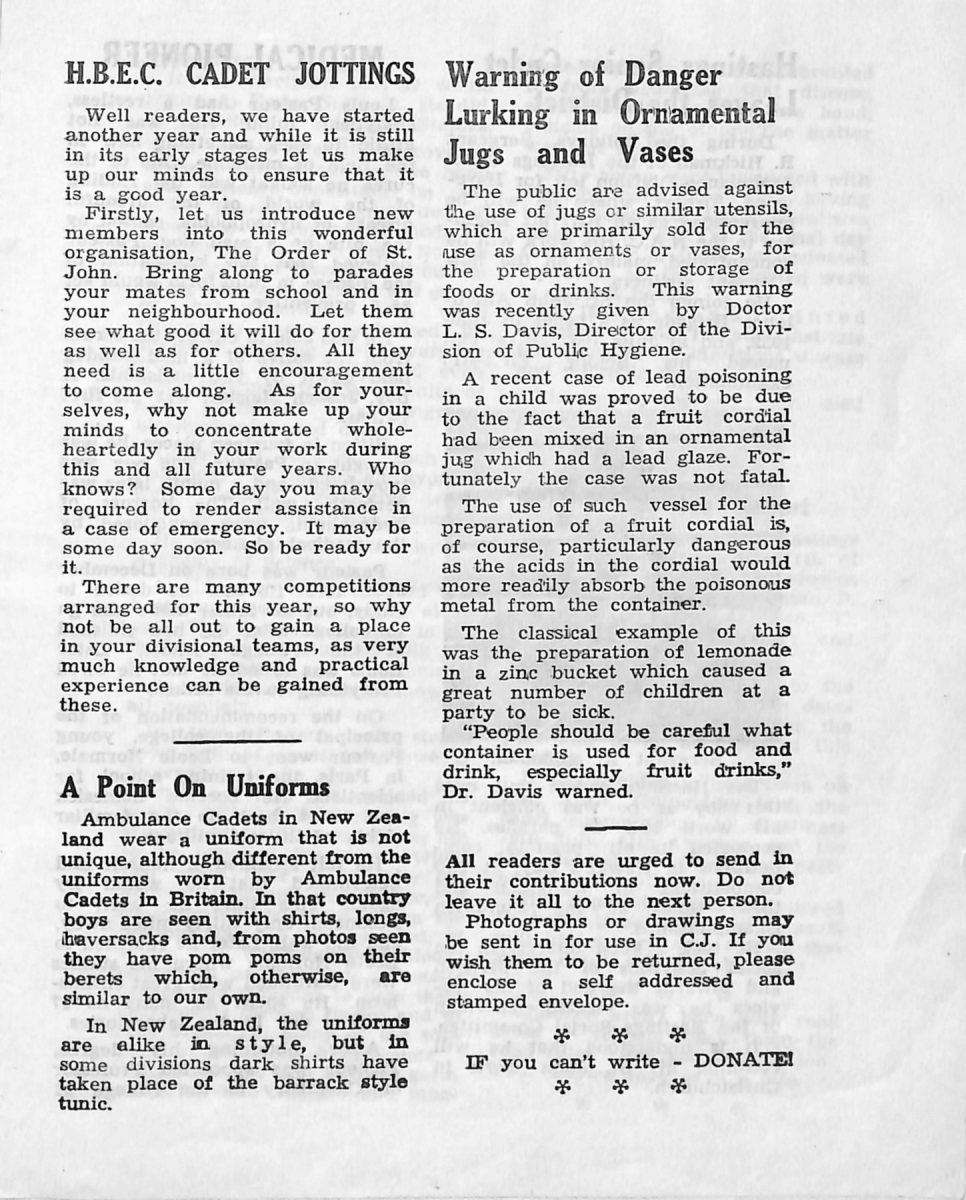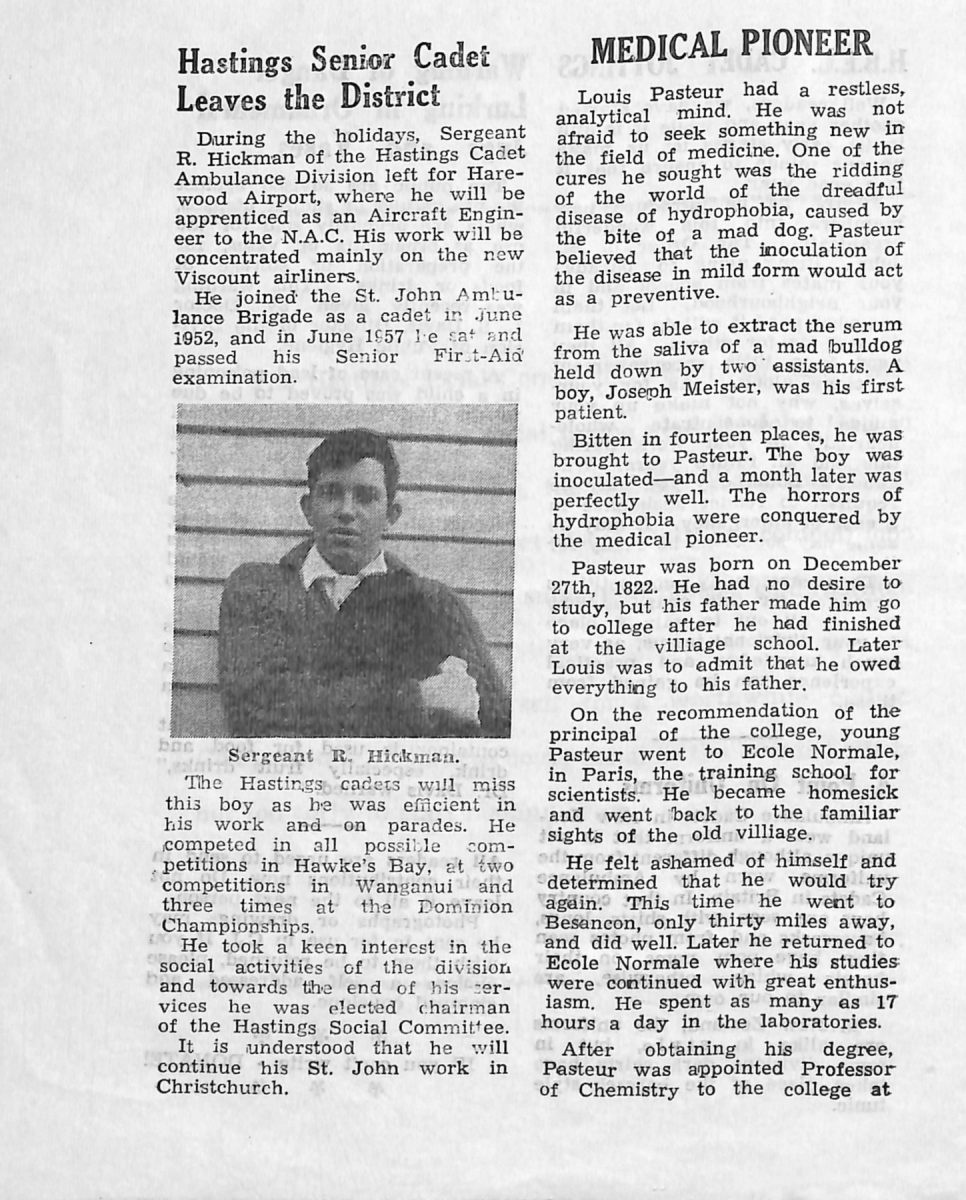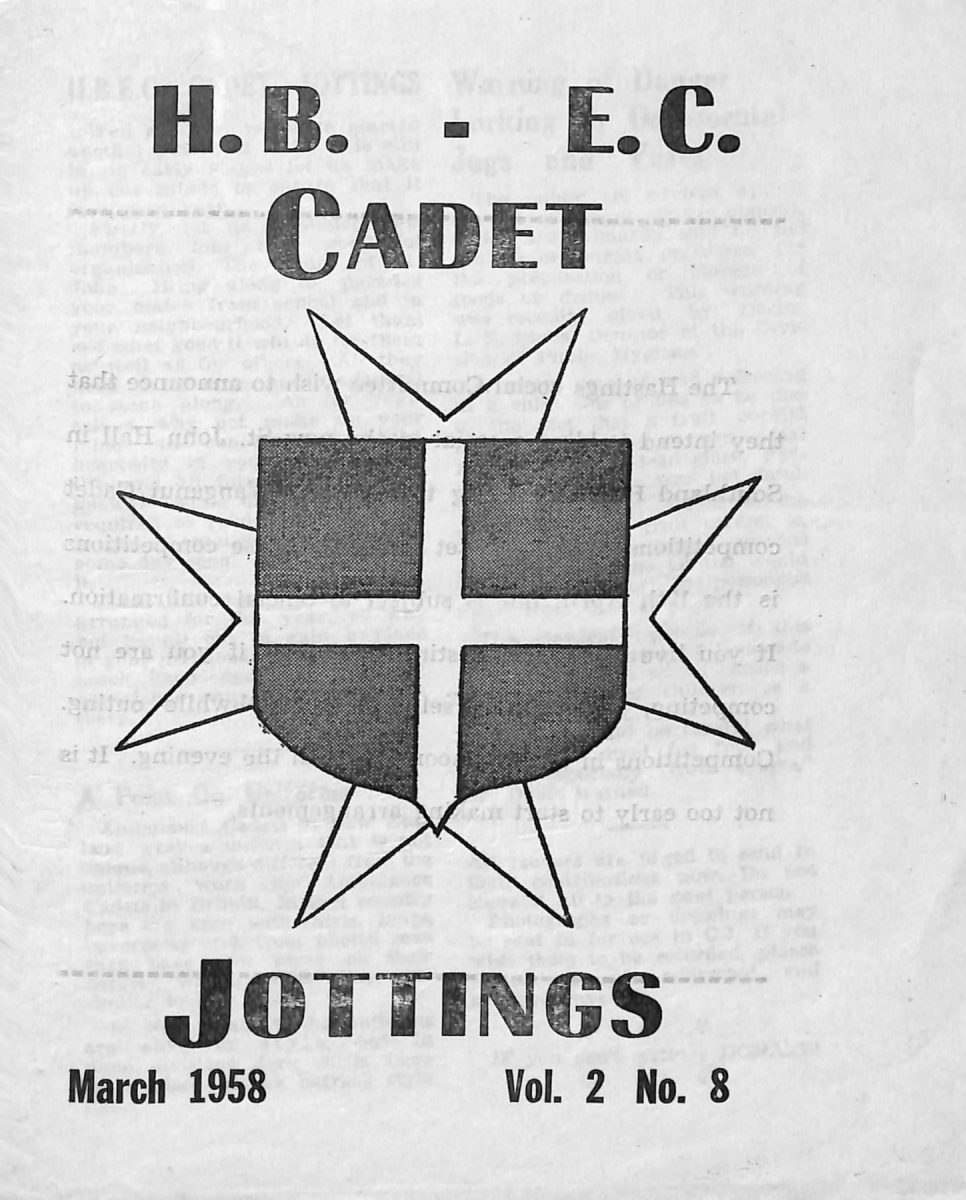- Home
- Collections
- TOBIN JS
- The Order of St John
- Cadet Magazine 20 1958
Cadet Magazine 20 1958
The Hastings social Committee wish to announce that they intend holding a social in the new St. John Hall in Southland Road, following the H.B.E.C.-Wanganui Cadet competitions. The date set down for these competitions is the 19th. April, but is subject to official confirmation. If you live outside of Hastings and even if you are not competing, prepare yourself for a worthwhile outing. Competitions in the afternoon, social in the evening. It is not too early to start making arrangements.

H.B.E.C. CADET JOTTINGS
Well readers, we have started another year and while it is still in its early stages let us make up our minds to ensure that it is a good year.
Firstly, let us introduce new members into this wonderful organisation, The Order of St. John. Bring along to parades your mates from school and in your neighbourhood. Let them see what good it will do for them as well as for others. All they need is a little encouragement to come along. As for yourselves, why not make up your minds to concentrate wholeheartedly in your work during this and all future years. Who knows? Some day you may be required to render assistance in a case of emergency. It may be some day soon. So be ready for it.
There are many competitions arranged for this year, so why not be all out to gain a place in your divisional teams, as very much knowledge and practical experience can be gained from these.
A Point on Uniforms
Ambulance Cadets in New Zealand wear a uniform that is not unique, although different from the uniforms worn by Ambulance Cadets in Britain. In that country boys are seen with shirts, longs, haversacks and, from photos seen they have pom poms on their berets which, otherwise, are similar to our own.
In New Zealand, the uniforms are alike in style, but in some divisions dark shirts have taken place of the barrack style tunic.
Warning of Danger Lurking in Ornamental Jugs and Vases
The public are advised against the use of jugs or similar utensils, which are primarily sold for the use as ornaments or vases, for the preparation or storage of foods or drinks. This warning was recently given by Doctor L.S. Davis, Director of the Division of Public Hygiene.
A recent case of lead poisoning in a child was proved to be due to the fact that a fruit cordial had been mixed in an ornamental jug which had a lead glaze. Fortunately the case was not fatal.
The use of such vessel for the preparation of a fruit cordial is, of course, particularly dangerous as the acids in the cordial would more readily absorb the poisonous metal from the container.
The classical example of this was the preparation of lemonade in a zinc bucket which caused a great number of children at a party to be sick.
“People should be careful what container is used for food and drink, especially fruit drinks,” Dr. Davis warned.
All readers are urged to send in their contributions now. Do not leave it all to the next person.
Photographs or drawings may be sent in for use in C.J. If you wish them to be returned, please enclose a self addressed and stamped envelope.
IF you can’t write – DONATE!

Hastings Senior Cadet Leaves the District
During the holidays, Sergeant R. Hickman of the Hastings Cadet Ambulance Division left for Harewood Airport, where he will be apprenticed as an Aircraft Engineer to the N.A.C. His work will be concentrated mainly on the new Viscount airliners.
He joined the St. John Ambulance Brigade as a cadet in June 1952, and in June 1957 he sat and passed his Senior First-Aid examination.
The Hastings cadets will miss this boy as he was efficient in his work and on parades. He competed in all possible competitions in Hawke’s Bay, at two competitions in Wanganui and three times at the Dominion Championships.
He took a keen interest in the social activities of the division and towards the end of his services he was elected chairman of the Hastings Social Committee.
It is understood that he will continue his St. John work in Christchurch.
Photo caption – Sergeant R. Hickman
MEDICAL PIONEER
Louis Pasteur had a restless, analytical mind. He was not afraid to seek something new in the field of medicine. One of the cures he sought was the ridding of the world of the dreadful disease of hydrophobia, caused by the bite of a mad dog. Pasteur believed that the inoculation of the disease in mild form would act as a preventive.
He was able to extract the serum from the saliva of a mad bulldog held down by two assistants. A boy, Joseph Meister, was his first patient.
Bitten in fourteen places, he was brought to Pasteur. The boy was inoculated – and a month later was perfectly well. The horrors of hydrophobia were conquered by the medical pioneer.
Pasteur was born on December 27th, 1822. He had no desire to study, but his father made him go to college after he had finished at the villiage [village] school. Later Louis was to admit that he owed everything to his father.
On the recommendation of the principal of the college, young Pasteur went to Ecole Normale, in Paris, the training school for scientists. He became homesick and went back to the familiar sights of the old villiage.
He felt ashamed of himself and determined that he would try again. This time he went to Besancon, only thirty miles away, and did well. Later he returned to Ecole Normale where his studies were continued with great enthusiasm. He spent as many as 17 hours a day in the laboratories.
After obtaining his degree, Pasteur was appointed Professor of Chemistry to the college at

Strasbourg.
It was inevitable that he would return to Ecole Normale. He did, as Director of Scientific Studies.
His various scientific discoveries brought him honour on one hand and violent opposition on the other. There was a great deal of ignorance in regard to medicine and surgery at this time. No one suspected that disease was due to living microbes, bacteria and germs or that cleanliness was vital. Operations were performed by surgeons wearing their everyday frock-coats with dirty and even rusty instruments. The results of such operations was gangrene, blood poisoning and death.
Contagious diseases such as smallpox, T.B., cholera and typhoid were rampant, preventive treatment by vaccination was unknown.
He was awarded a prize by the Academy of Science.
At this time he discovered that heat could destroy harmful elements. This fact was to lead to the modern pasteurization of milk and the sterilization of instruments and dressings as practised now in all hospitals.
In 1868, Pasteur was struck down with paralysis, but, however he was not to die.
Little by little he regained his health. Although his left leg was affected, his brilliant mind was not so he resumed his work. When two years later war broke out between Germany and France, he concentrated his attentition [attention] on the terrible state of the wounded, of whom 70% were dying of blood poisoning or gangrene. Pasteur begged the surgeons to pass their instruments through flames and to heat dressings. Many of the surgeons resented the interference.
His discovery that virolent [virulent] germ converted into vaccine and inoculated into an animal prevented it from acquiring that disease, evoked enthusiasm on one hand, ridicule on the other. The matter was put to trial.
Fifty sheep were inoculated with anthrox [anthrax] twenty-five first having been vaccinated. Again there was great excitement. On the final day twenty-four of those unvaccinated lay dead; all the vaccinated were in perfect health.
In 1888 he was appointed director of the Pasteur Institute for research of infectious disease and microbic work. This great medical man died in 1895.
Social Committee Report
At the meeting of the Hastings Social committee on the 11th of February, the members present voted T. England as chairman, P. Hawke as deputy-chairman, C. Christophersen as secretary and J. Roberts as treasurer.
As the hall will be let to the public during the year, the dates for the Hastings socials for the year had to be arranged at this meeting.
It was decided to hold them on 19th. April, (coinciding with the cadet competitions in Hastings) 19th July, 11th October and the 6th December. (Christmas party and break-up).
The superintendents are urged to keep these nights free as it will be by very slim chance that these dates will be altered.
Children aren’t born with road sense – schools teach them the road rules. Are you helping too Your advice may save a life.

Pliers and Razor Used During Operation
With no anaesthetics and only a pair of pliers and a blade razor to work with, two men recently operated on a young boy at the Mokau Beach (Taranaki) to remove a fish hook from his leg.
One of the men, the grandfather of the boy, said that the shank of the hook went right into the boy’s leg. “There was nobody to help us, so I got a pair of pliers from the car and the other man got a ‘cut throat’ razor and we did the job ourselves.”
“There were no anaesthetics to give the boy, but he was very brave. To locate the barb we had to cut into his leg and then pull it out. During that time he cried out only once.”
After the removal of the hook the boy was taken to the grandfather’s home where the wound was properly dressed.
Senior Division Formed In Waipawa
A Waipawa senior division of the St. John Ambulance Brigade was formed at a general meeting held on the 10th. of February.
Mr G. Shapcott, who has had 27 years experience in the Wellington Ambulance Division, was appointed superintendent and Mrs. G. Tannahill as secretary.
A course of lectures is to be given by a doctor and training will include first-aid and a thorough knowledge of the Holger-Neilson method of resuscitation. Weekly parades will be held and sports functions and meetings will be attended.
Prevention of Accidents
All you cadets should be fully aware that the prevention of accidents is better than the best possible cure. You should help by every means in your power to prevent the carelessness that causes such a large number of accidents at home, at school, in work, in play and in and out of doors. Treat with respect cautionary signs such as “Do not touch” and “Danger”. There is always a good reason for them.
The commonest forms of accidents can be summarised under the following headings:-
In the home,
The roads,
The factory and workshop,
Fire,
Poison,
Firearms,
Boats and bathing.
In the home:- There are numerous things which can result in accidents in the home. Briefly some of them are slippery [slippery] floors, loose mats, overhanging pot handles, long and frayed flex on irons and hot water jugs, unguarded heaters, long tablecloths with dangerous objects on the top, knives within the reach of young children and many others. If you can see any way in preventing such accidents, you should point them out to the person concerned.
The roads:- The majority of first-aid cases dealt with each year are the results of road accidents, caused by careless motorists, bicyclists, pedestrians and children. A large toll of life is taken each year on the roads and many people are maimed for life through injury. All cadets should know the “Road Code”. These booklets are available at your

local Transport Department Office and are free.
Factory and workshop:- Most factories today have efficient first-aid services. The prevention of accidents in the factories therefore, does not really come under the cadet’s work. Labour Department officials make regular inspections of these places. In the workshop, be careful when using tools. Replace them in their proper racks after use. Wounds are commonly caused by chisels being left on benches, and the worker, brushing away shavings, gashes himself on them.
Fire:- These are nearly always caused through carelessness. Do not leave matches in the reach of small children. Make sure a fire is extinguished or well guarded. Have a fire extinguisher handy or know where a hose is kept. Also be familiar with the local fire brigade phone number.
Poison:- It is important that any bottle, packet or tin marked ‘poison’ should be kept in a locked cupboard and not in the same place as medicines. Poisons supplied by chemists are sold in corrugated bottles which can easily be felt and will not be mistaken in the dark. Too many children take poison. You can help by indicating these points to the head of the house.
Firearms:- A sporting gun or rifle should never be pointed at a human being, whether loaded or not, but should be carried with the muzzle pointing to the ground or in the air and never at full cock. If handed a gun or rifle, you cadets should request the owner to see that there is no cartridge in the breech or in the magazine. Care should also be taken to see that there is no foreign body lodged in the barrel. Even a small bit of grit has been known to cause an explosion when fired.
Boats and bathing:- If a person is unfamiliar with a boat, he should not take it out on his own, but wait until some competitant [competent] person is available to help. Never swim in a strange place unless on the advice of local inhabitants. False cries for help should never be given and always swim amongst a crowd or in an area marked off by a surf patrol.
Everyone should help in some way to prevent the alarmingly high number of accidents which occur every day.
The only expense incurring in the production of this magazine is the postages. As divisions outside of Hastings receive their copies through the post, a donation from these centres would be very much appreciated.
– Editor.
SANTA ARRIVES BY AMBULANCE
Although it is quite common to see Santa arriving by Fire-engine, his transport changed to an ambulance when he visited some children in Auckland last December.
Escorted by traffic officers, he arrived at the St. John Christmas party at the Rutland Street station perched on the bonnet of an ambulance.
The 50 odd children who were there to greet him received lollies and presents and all had a wonderful time.

Lepers Thrive On a Pretty Little Island
A group of 540 lepers, some of them horribly disfigured, live on a pretty little island off Hong Kong in a mood of cheerful optimism. They are being cured completely and permanently. They know that one day the gnarled swellings will disappear from their faces and bodies and they will sail away with a clean bill of health to join their families again.
The island off Hong Kong used as a leprosarium is called Hai Ling Chou – a play on Chinese and English words, for it means “Isle Of Happy Healing.” Here Dr. Neil Duncan Fraser, 57-year-old medical missionary, and his staff have fought leprosy since 1951, curing nearly 200 afflicted Chinese so far. Their nursing supervisor is Miss Irene Moore, a Canadian of Bothwell, Ontario.
Working with Government funds and partly on funds drummed up by an energetic committee of citizens in Hong Kong, Dr. Frazer and his staff have built a picturesque little township of greystone houses and dormitories on the hillsides, where many inmates probably have better accommodation than they enjoyed before they caught the disease.
Trees and bamboos have been transplanted to decorate the scrub covered slopes; workshops have been built for making embroidery, carvings and wooden models; and there is now a 2,000,000-gallon reservoir.
The rule of the island is that those who can must do any work required of them in return for their free treatment, food and housing. So farmer patients produce vegetables, tend the bull and 26 cows and look after the flock of ducks. Their greatest pride is the piggery. With a pig population running at between 100 and 200, they made a profit of nearly £600 in 1956 to help finance their island. Other patients have busied themselves cutting a road round the island, while those too crippled to do active work are taught to make brooms, baskets and rattan furniture.
All objects made by the lepers are carefully sterilised before leaving the island; last year they made more than £625 in the colony’s shops.
Through the high spirits of these stricken people, they make the dreaded disease of Leprosy seem merely like a minor illness.
Note to District Officers And All Cadets
Send in information about your division and district now. Publicise your area, and if any of you have any stories of interest, send them in. The hardest part in the production of this magazine is finding the news to fill the pages.
It is hoped to publish a full page photograph each issue. If you have one suitable for publication, send it in with your name and division to the Editor. Cadet Jottings, 403 Cornwall Road, Hastings. Place it between two pieces of cardboard as this prevents bending and damage. If it is to be returned, send your address also.

Non-commercial use

This work is licensed under a Attribution-NonCommercial 3.0 New Zealand (CC BY-NC 3.0 NZ).
Commercial Use
Please contact us for information about using this material commercially.Can you help?
The Hawke's Bay Knowledge Bank relies on donations to make this material available. Please consider making a donation towards preserving our local history.
Visit our donations page for more information.
Description
Published from June 1955 to August 1959; first two issues known as “The Cadet”, later issues “Jottings”
Business / Organisation
The Order of St JohnFormat of the original
BookletDate published
March 1958People
- C Christopherson
- Dr L S Davis
- T England
- P Hawke
- Sergeant R Hickman
- J Roberts
- G Shapcott
- Mrs G Tannahill











Do you know something about this record?
Please note we cannot verify the accuracy of any information posted by the community.